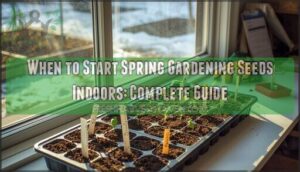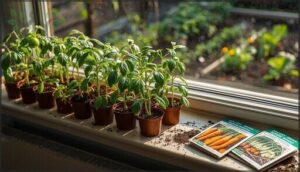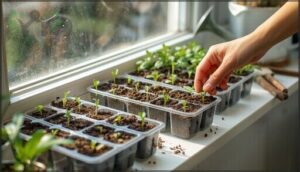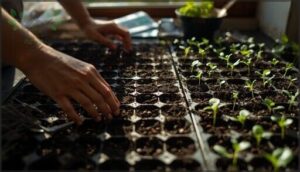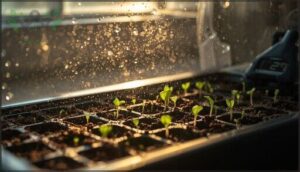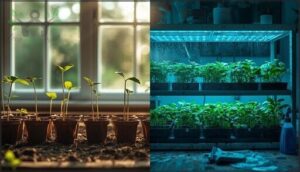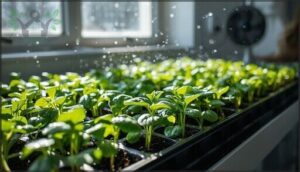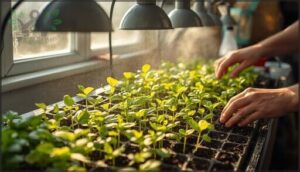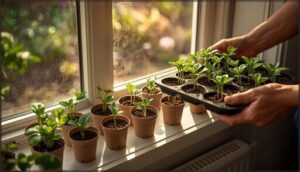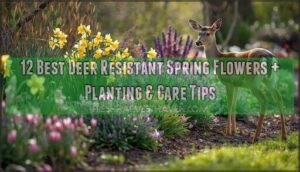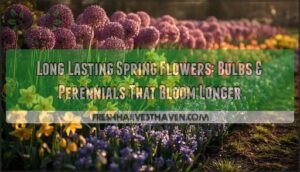This site is supported by our readers. We may earn a commission, at no cost to you, if you purchase through links.
Your garden’s success hinges on a decision you’ll make weeks before the soil warms. Start seeds too early, and leggy, overgrown seedlings won’t survive the move outdoors. Wait too long, and you’ll miss your region’s narrow window for transplanting before summer heat arrives.
Most gardeners don’t realize that calculating when to start spring gardening seeds indoors isn’t about picking a random date in March—it’s about working backward from your last expected frost. Tomatoes need 6–8 weeks of indoor growth, while cucumbers thrive with just 3–4 weeks under lights.
Understanding these timelines transforms uncertain guesswork into a systematic approach that produces vigorous transplants ready to flourish the moment conditions allow.
Table Of Contents
- Key Takeaways
- When to Start Spring Gardening Seeds Indoors
- Which Seeds Should Be Started Indoors
- Choosing Containers and Seed Starting Mix
- Sowing Seeds and Providing Optimal Conditions
- Caring for Seedlings Indoors
- Preparing Seedlings for Outdoor Transplant
- Frequently Asked Questions (FAQs)
- When can I plant seeds indoors?
- When should I start planting seeds?
- Should I start seeds indoors or outside?
- When should you plant seeds in the winter?
- How do I start seeds indoors?
- When is the best time to plant a garden?
- Is January too early to start seeds indoors?
- Can you start seeds inside too early?
- When to start stock seeds indoors?
- Is it worth starting seeds indoors?
- Conclusion
Key Takeaways
- Successful seed starting depends on working backward from your last frost date—tomatoes need 6–8 weeks indoors, peppers require 8–10 weeks, while cucumbers thrive with just 3–4 weeks of indoor growth before transplanting.
- Your USDA hardiness zone and local microclimates (elevation, proximity to water, urban heat islands) can shift frost dates by weeks, making zip code-specific frost calculators more reliable than generalized zone maps for timing your seed starts.
- Not all crops benefit from indoor starting—taproot vegetables like carrots and beets, plus legumes like beans and peas, suffer from transplant shock and perform better when sown directly into warm outdoor soil after the last frost.
- The hardening-off process over 7–14 days is non-negotiable for transplant success, gradually exposing seedlings to outdoor conditions while warm-season crops need soil temperatures of at least 60°F and cool-season crops can tolerate transplanting 2–3 weeks before the frost-free date.
When to Start Spring Gardening Seeds Indoors
Starting seeds indoors gives you a real advantage, but timing is everything. Get this wrong, and you’ll end up with leggy seedlings or plants that aren’t ready when your garden is.
Starting seeds indoors gives you an advantage, but poor timing leads to leggy seedlings or plants that miss their garden window
In this section, we’ll walk through how to figure out when to start your seeds so they’re perfectly sized and hardened off by planting day.
Calculating Your Last Frost Date
Your last frost date is the final spring day when freezing temperatures occur in your area. Finding it’s essential—it anchors your entire seed-starting timeline. Use the National Gardening Association’s frost date calculator or NOAA’s interactive map for your zip code. These tools show multiple probability levels, so you can choose the 90% confidence date for safety with tender crops.
The average last freeze can be found on a NOAA map. Microclimates matter: elevation, proximity to water, and urban heat islands shift dates by weeks within the same hardiness zone.
Recommended Seed Starting Timelines
Now that you’ve found your frost date, count backward to determine when seeds need indoor sowing. Most spring vegetables start indoors 4–10 weeks before that date—the extension agency data confirms this window works across regions. Tomatoes and peppers need 6–8 weeks; cabbage and broccoli require similar timing. Cucumbers and melons are shorter at 3–4 weeks.
Horticultural organization guidance recommends checking individual seed packets, as crop-specific windows vary. To guarantee healthy seedling growth, consider that fluorescent lights work best.
This countdown method ensures transplants are ready exactly when outdoor conditions allow safe planting.
Adjusting for Your Climate Zone
Your USDA hardiness zone determines when frost leaves your area—and that’s your anchor point. Cold zones (3–5) start seeds 8–10 weeks early; temperate zones (6–7) use 6–8 weeks. Warmer regions (8–10) can begin as early as January.
But don’t stop there. Microclimates shift frost dates by weeks within the same county. Check local analog climate tools and connect with nearby gardeners to fine-tune your frost date planning. Your specific neighborhood matters more than the zone map alone.
Timing for Common Vegetables and Herbs
Once you’ve nailed your zone, get specific with each crop. Tomatoes need 6–8 weeks indoors before your frost date—start them mid-March for a mid-May transplant. Peppers demand 8–10 weeks, so begin in late February. Broccoli requires only 5–7 weeks; early March works well.
Basil sprouts fast at 5–6 weeks, while parsley crawls along for 8–10 weeks, needing an early February start for spring planting.
Which Seeds Should Be Started Indoors
Not every seed belongs on a windowsill. Some crops thrive when you give them a sheltered start indoors, while others resent being transplanted and perform better when sown directly into garden soil.
Understanding which seeds benefit from indoor starting—and which don’t—will save you time, effort, and disappointment as you plan your spring garden.
Warm-Season Crops (Tomatoes, Peppers, Eggplants)
Tomatoes, peppers, and eggplant thrive when you control their environment from the start. Begin tomatoes 4–6 weeks before your frost-free date, peppers 6–8 weeks prior, and eggplant 8–12 weeks ahead—the longest lead time of warm-season crops. Best germination happens at 70–90°F soil temperature.
Proper seedling spacing and transplant readiness dramatically improve success rates while preventing common issues like damping-off disease.
Cool-Weather Crops (Broccoli, Cabbage, Cauliflower)
Unlike their heat-loving cousins, broccoli, cabbage, and cauliflower demand cooler starting seeds indoors windows. Begin these crops 4–8 weeks before your last frost—when germination temperatures between 75–85°F produce 90% success rates. Here’s your indoor timeline:
- Broccoli: 4–6 weeks before frost-free date
- Cabbage: 6–8 weeks prior to transplant timing
- Cauliflower: 6–8 weeks for best variety selection
- All three: Ready at 6–8 true leaves
Common problems like leggy stems occur when seed starting dates run too early.
Flowers and Herbs Suitable for Indoor Sowing
Annual flowers and culinary herbs thrive with indoor starts, giving you control over sowing schedules and light requirements. Fast-germinating flower seeds like zinnia and marigold, plus easy herb varieties such as basil and thyme, respond well to early care. Seed viability stays high indoors, supporting vigorous flower cultivation and herb growing.
| Flower Varieties | Herb Varieties |
|---|---|
| Zinnia | Basil |
| Marigold | Thyme |
| Cosmos | Oregano |
| Snapdragon | Sage |
Crops Best Sown Directly Outdoors
Some crops skip the indoor stage entirely—their nature demands it. Taproot sensitivity in carrots and beets makes transplanting risky, while legume shock stunts beans and peas. Cucurbit success with squash and pumpkins comes from sowing directly into warm soil after the last frost. Quick greens and herbs like cilantro thrive from outdoor sowings timed to your climate data. At scale, cost savings favor direct seeding for high-density crops throughout the growing season.
- Carrots, beets, and radishes (taproots damaged by transplanting)
- Beans and peas (legumes prone to severe transplant shock)
- Squash, pumpkins, and cucumbers (large seeds establishing quickly in warm soil)
- Baby spinach and cilantro (quick-maturing greens better from successive sowings)
- High-density crops where direct seeding reduces labor and greenhouse costs
Choosing Containers and Seed Starting Mix
The right containers and growing medium can make or break your seed-starting success. You don’t need expensive equipment, but choosing the proper setup ensures your seedlings develop strong roots and stay healthy from day one.
Let’s look at the key elements you’ll need to get your seeds off to a solid start.
Selecting The Right Seed-Starting Containers
You’ll find seed starting containers in three main categories: commercial plastic plug trays, reusable household items, and biodegradable pots.
Standard 72-cell trays work for most varieties and eliminate repotting in 85% of cases.
Clean yogurt cups or cottage cheese tubs cut costs by 40% when you add drainage holes.
Biodegradable options reduce transplant shock by 70% since roots grow right through the container material.
Best Soil Mixes for Seed Germination
The foundation for vigorous seedlings starts with a sterile seed-starting mix engineered for germination. Standard DIY recipes blend equal parts peat moss, perlite, and vermiculite, delivering high porosity and low nutrient content that limits pathogen growth.
- Coco coir retains eight times its dry weight in water and maintains pH 6.0–6.8
- Peat-based mixes need pH adjustment from their acidic 3.5–4.5 baseline
- Nutrient solution should reach EC 0.8–1.2 mS/cm for seedling-stage feeding
- Rockwool cubes achieve 70% germination rates with controlled moisture distribution
- Avoid compost in seed-starting mix—it introduces damping-off pathogens and anaerobic conditions
Proper Drainage and Airflow Considerations
Once you’ve settled on a seed starting mix, focus on container drainage and airflow. Without proper drainage holes, seedlings risk overwatering and root rot—imagine soggy boots after a rainstorm.
Humidity control matters, too; venting domes and spacing trays boost air circulation.
Material effects count—fabric pots offer better oxygen and root health than black plastic, supporting strong seed germination.
Labeling and Organizing Seed Trays
Drainage and airflow keep roots healthy, but knowing which seedling is which keeps your garden on track. Label durability matters—pencil on plastic tags outlasts felt markers that fade in weeks.
Grid coding systems let you track dozens of varieties with fewer physical labels, and digital integration through QR codes can link trays to detailed planting notes.
Label immediately at sowing for foolproof seedling care.
Sowing Seeds and Providing Optimal Conditions
Once your containers are filled with seed-starting mix, it’s time to get those seeds in the ground and create the right environment for germination.
Small mistakes at this stage—planting too deep, inconsistent moisture, or poor lighting—can set your seedlings back weeks or stop them from sprouting altogether.
Let’s walk through the key factors that’ll help your seeds germinate strong and grow into healthy transplants.
Correct Sowing Depth and Spacing
To achieve best depth when sowing seeds, follow this simple rule: plant each seed at twice its diameter. For most vegetable seeds, this means 1/8 to 1/4 inch deep.
Seed spacing matters just as much—proper seed sowing techniques prevent overcrowding effects that stunt root development. Space rows 1 to 2 inches apart in trays to improve tray utilization while maintaining healthy airflow between seedlings.
Maintaining Consistent Temperature and Humidity
Once your seeds are sown at the right depth, you’ll need to dial in temperature and humidity for germination success. Most vegetable seeds thrive when soil temperature stays between 68°F and 75°F—that’s the best range for seed germination.
Keeping humidity near 95% during sprouting improves rates considerably. Temperature fluctuations beyond 4°C can slash germination by 35%, so use seedling heat mats and dome covers for humidity control and consistent warmth.
Using Grow Lights Vs. Natural Light
When starting seeds indoors, you’ll face a choice between grow lights and natural light. Seedlings under grow lights need 14 to 16 hours daily, while quality LEDs positioned 12-18 inches above trays boost germination rates by up to 40%.
Light spectrum matters—blue aids seedling health and compact growth, while natural window light costs nothing but often produces leggier plants with uneven growth rates.
Watering Techniques to Prevent Disease
With seedling health, how you water is as important as when. Bottom watering keeps foliage dry, slashing damping-off risk by up to half. Early-day irrigation lets surfaces dry before night. Clean water source and media sanitation are non-negotiable. Airflow importance? Huge—use a fan to cut humidity and mold.
- Bottom watering prevents disease
- Morning irrigation limits fungal risk
- Clean trays boost seedling health
Caring for Seedlings Indoors
Once your seeds sprout, the real work begins. Healthy seedlings need consistent attention to light, water, and space as they develop true leaves and sturdy stems.
Here’s how to keep your indoor starts thriving until they’re ready for the garden.
Thinning and Transplanting to Larger Pots
When your homegrown seedlings develop two true leaves—usually within 7 to 21 days after germination—it’s time for thinning seedlings. Snip extras at soil level rather than pulling to avoid root damage and transplant shock.
Once seedlings outgrow their cells, transplanting them into larger containers with adequate volume strengthens stems, expands root systems, and improves disease prevention by enhancing air circulation around each plant.
Preventing Damping-Off and Mold
Damping-off strikes fast when conditions favor fungal growth. Start with soil sterilization—use pasteurized seed starting mix in clean containers to eliminate pathogens before germination.
Bottom watering techniques keep surfaces dry, reducing mold by 30%. Add air circulation with a small fan for 6–8 hours daily.
Temperature management matters—warm soil (70–75°F) speeds emergence and cuts disease risk. Try organic controls like cinnamon or Bacillus subtilis for extra protection.
Monitoring Growth and Adjusting Care
Growth tracking isn’t guesswork—image-based monitoring can predict seedling height with 99.7% accuracy. Check your plants every few days and make environmental adjustments based on what you see.
- Light quality matters: LED grow lights in the 400–700 nm range boost nutrient content by up to 50%
- Fertilizer adjustments: Apply balanced liquid fertilizer every 2–4 weeks during active growth
- Data-driven adjustments: Track leaf area to fine-tune water and light, improving growth rates by 25%
Recognizing Common Seedling Problems
Even small symptoms can snowball into major losses if you miss the early signs. Damping-off disease causes rapid collapse when soils stay too wet, while leggy seedlings signal insufficient light intensity.
Watch for yellowing leaves indicating nutrient deficiencies, flying fungus gnats near your seed starting mix, and wilting after transplanting—all red flags requiring immediate adjustment to your seedling care routine.
Preparing Seedlings for Outdoor Transplant
Moving seedlings from the controlled environment indoors to the unpredictable conditions outside requires careful preparation. Rushing this shift can shock your plants and set back weeks of growth.
The hardening-off process protects your investment and gives seedlings the strength they need to thrive in their permanent garden home.
Hardening Off Seedlings Before Planting
Before transplanting seedlings outdoors, you’ll need to harden them off gradually over 7–14 days to prevent transplant shock. This process strengthens your plants’ temperature tolerance and light acclimation while building resistance to wind and environmental stress.
- Start with 2–3 hours of outdoor exposure in shade, increasing daily
- Provide wind protection during initial days to prevent tissue damage
- Practice watering reduction between exposures to strengthen root systems
- Wait until nighttime temperatures stay above 45°F before overnight acclimation
Timing Transplant Based on Frost Dates
Once your seedlings are hardened off, timing transplant around your last frost date becomes your next critical step.
Most warm-season vegetables like tomatoes and peppers should go outdoors 1–2 weeks after the frost-free date, when soil temperatures reach at least 60°F.
Cool-season crops such as broccoli can handle transplanting 2–3 weeks before that date, tolerating light frosts down to 28–30°F.
Handling and Transplanting Seedlings Safely
How you handle your seedlings at transplant directly affects their survival. Studies show that grabbing stems increases mortality by up to 30%, so always hold seedlings by their leaves or root ball.
Follow these practices for better transplant survival:
- Keep roots moist and minimize air exposure to under five minutes
- Select only strong, healthy seedlings for transplanting
- Avoid dropping or roughly handling seedling trays
- Dip roots in water briefly before planting
- Maintain consistent transplant depth across all seedlings
Protecting Young Plants From Outdoor Stress
After transplanting seedlings carefully, protect them from outdoor stress. Apply a 2–4 inch mulch layer around young plants to reduce evaporation by 35% and lower soil temperatures. Use shade cloth with 40% coverage to prevent leaf scorch in hot weather.
Floating row covers raise nighttime temperatures by 2–5°C, protecting against late frosts. Wind barriers reduce mechanical stress and boost root establishment rates by 30%.
Frequently Asked Questions (FAQs)
When can I plant seeds indoors?
The secret to timing indoor seed starting lies in working backward from your region’s last frost date—usually 6 to 8 weeks prior for most vegetables and flowers.
When should I start planting seeds?
Most vegetable seeds need 6-8 weeks indoors before your frost date.
Use a planting time calculator to determine seed starting dates for your regional climate zones, following seed packet timing for vegetable-specific timelines and best indoor start benefits.
Should I start seeds indoors or outside?
Starting seeds indoors suits warm-season crops like tomatoes and peppers, especially in short-season climates.
Plant hardiness, space requirements, and time investment matter—but indoor seed starting delivers stronger transplants and higher yields.
When should you plant seeds in the winter?
Plant hardy perennials and cool-season vegetables outdoors between January and February for natural cold stratification.
This winter sowing timing gives seeds 60–90 days of cold exposure, triggering spring germination when temperatures rise.
How do I start seeds indoors?
Fill trays with sterile seed starting mix, sow at proper depth, and provide consistent warmth and light. Water gently from below, label everything, and maintain humidity—these seed starting basics prevent common mistakes when starting seeds indoors.
When is the best time to plant a garden?
The best time to plant a garden depends on your last frost date and regional climate zone.
Use seed packet info and almanac planting dates to map your growing season timeline.
Is January too early to start seeds indoors?
For most temperate climates, January seed starting is too early—only warm zones or slow crops like peppers justify it.
Climate zone matters more than calendar; starting seeds indoors succeeds when timed to your frost date.
Can you start seeds inside too early?
Yes, starting too early is like putting a marathon runner on a treadmill for months—you’ll get leggy seedlings, root binding, and transplant shock.
Sowing dates matter, or indoor seed starting backfires with stunted growth and disease risks.
When to start stock seeds indoors?
Stock seeds thrive when you start them indoors 6–8 weeks before your last frost date. In cooler regions, extend that window to 8–10 weeks, giving transplants time to establish before spring’s unpredictable weather arrives.
Is it worth starting seeds indoors?
Indoor seed starting delivers substantial rewards—20% higher yields, 85–95% germination rates, and access to 200+ varieties. Your effort investment pays off through cost savings and climate control, transforming your garden’s potential.
Conclusion
Picture a gardener who started tomatoes in February, only to watch them stretch thin and pale by April—too weak to survive transplant. That’s the cost of ignoring timing.
When you start spring gardening seeds indoors based on your frost date and each crop’s specific needs, you’re not just planting—you’re orchestrating. The seedlings you nurture now become the backbone of your harvest, strong enough to thrive when garden conditions align perfectly.
- https://www.creativevegetablegardener.com/when-to-start-seeds-indoors-zone-5/
- https://blogs.cornell.edu/fruition/2024/04/04/starting-seeds/
- https://www.reddit.com/r/Minnesota_Gardening/comments/10x3rbh/when_should_i_start_my_seeds_indoors/
- https://growincrazyacres.com/germination-chart/
- https://www.mordorintelligence.com/industry-reports/us-garden-seeds-market

